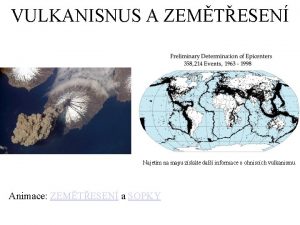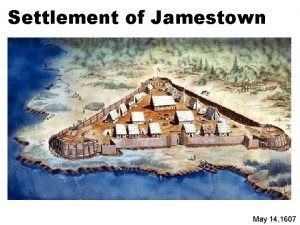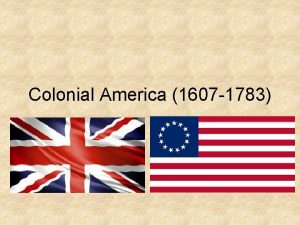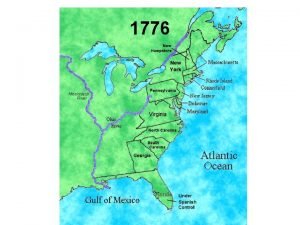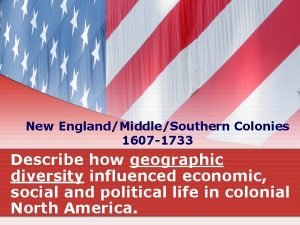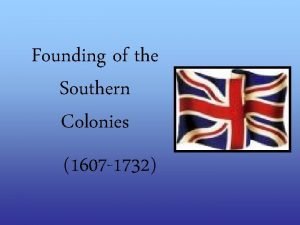APUSH Period 1 Review 1491 1607 Maize Different















- Slides: 15

APUSH Period 1 Review 1491 - 1607

Maize • “Different native societies adapted to and transformed their environments through innovations in agriculture, resource use, and social structure. ” • A) Impact of maize cultivation: – Very popular in the southwest – Societies developed vast irrigation systems (Pueblos in Rio Grande) • How did maize transform societies? – Less emphasis on hunting and gathering – Increase in population – Establishment of permanent villages with socially diverse societies • Tenochtitlan – 250, 000 people, social classes

Great Plains and Great Basin • Most natives lived off of hunting and gathering – Lack of natural resources – Large, flat area that was arid (dry) – Basin – Grassland- Plains • With the introduction of the horse, life on the Great Plains was drastically altered – Bison hunting became much easier – Natives with horses became stronger militarily • Natives in the Great Basin hunted bison and sheep – Like natives on the Great Plains, horses helped natives become more powerful

Northeast, Mississippi River Valley, and Atlantic Seaboard • Many societies were a mix of hunting and gathering, and agriculture and developed permanent villages • Iroquois (Present day NY and PA): – Adapted to their environment: • Burned forests to hunt and grow crops • Villages were built around maize • Iroquois were a matriarchal society: – Power was based on female authority – Women were instrumental in councils and decision-making – Women would tend to crops and oversaw community affairs while men hunted

Northwest And Present-Day California • Roughly 300, 000 natives lived in California prior to the arrival of Europeans – Most of these societies were based on hunting, gathering, and foraging • Gather nuts, fish, and hunted – Societies tended to be ruled by wealthy families • Chinooks – Advocated warrior traditions – Used advanced fighting techniques – Lived in longhouses which could house many families

The Columbian Exchange • Key Concept 1. 2 “Contact among Europeans, Native Americans, and Africans resulted in the Columbian Exchange and significant social, cultural, and political changes on both sides of the Atlantic Ocean. ” • The Columbian Exchange revolutionized life in the Americas, Europe, and Africa. • Big Ideas: – What were positives and negatives of the Columbian Exchange on both hemispheres? – What were reasons that led to European exploration?

The Columbian Exchange • B) Columbian Exchange and its impacts – What was it? • The exchange of plants, animals, culture, humans, diseases, etc. between the Americas, Europe, and Africa – Examples of goods: • Americas to Europe and Africa: potatoes, maize (corn), tomatoes • Europe to the Americas: wheat, rice, horses, chickens, oxen – Impact of exchange? • In Europe and Asia: massive population growth due to new food; increase in wealth; decrease in feudalism and a rise of capitalism • In Africa: Spanish and Portuguese used Africans from West Africa to be used as slaves in the Americas • In the Americas: spread of diseases (smallpox and measles), social classes (Mestizos), horse transformed Native life (made hunting easier), Encomienda system

European Expansion • Key Concept 1. 2, I: “European expansion into the Western Hemisphere generated intense social, religious, political, and economic competition and changes within European societies. ” • A) Reasons for European exploration: – Countries sought new sources of wealth – gold and silver – Economic and military competition – glory (defeat of the Spanish Armada by the English) – Spread Christianity – Spain • The Spanish often tried to convert Natives to Christianity – Spanish Mission System: • Outposts throughout the Americas to help convert Natives • Outposts were often military bases as well • 3 G’s – Gold, Glory, Gospel

European Expansion • C) Technology and trade – New technology aided exploration: • Sextant – could be used to find exact position on earth – more precise sailing • Caravel, compass, and quadrant improved sailing efficiency – Economic improvements: • Joint-stock companies – used to raise $ for explorations – Used in Jamestown (1607)

Spanish Exploration • Key Concept 1. 2, II: “The Columbian Exchange and development of the Spanish Empire in the Western Hemisphere resulted in extensive demographic, economic, and social changes. ” • A) Impact of Spanish exploration: – Deadly diseases: • Smallpox, malaria – Killed as many as 90% of Natives in some areas – not immune to European diseases – Introduction of new animals and crops: • Horse – transformed Native life on the Great Plains • Crops – wheat, rice, and sugar

Encomienda • B) Encomienda System – Native American labor was marshaled (arranged, assembled) on plantations – The goal was to use labor for agriculture and gain precious metal – Eventually, the encomienda system was replaced by African Slave Labor • New Laws of 1542 outlawed the encomienda system • C) Spanish and Portuguese traders acquired slaves from some West African groups – Slaves were used by the Spanish on plantations and mines • D) Spanish Caste System: – Incorporated Europeans, Africans, Natives • Europeans were at the top (peninsulares and creoles) • Mestizo and mulatos (mixed European and Native, European and African ancestry)

Nations Collide • Key Concept 1. 2, II: “In their interactions, Europeans and Native Americans asserted divergent worldviews regarding issues such as religion, gender roles, family, land use, and power. ” • A) Misunderstandings between each group – Gender – many Natives societies were matrilineal – Land – Natives did not own individual land – Religion – Natives believed in animism, polytheistic; shamans held power • Some useful aspects of each other’s cultures were eventually adapted: – Natives adapted technology – Europeans adapted agriculture techniques

Nations Collide • B) Native resistance to European encroachment and labor: – Natives sought to preserve political, economic, and religious autonomy (independence, self-rule) • Diplomatically and/or militarily • C) Debates over how non-Europeans should be treated: – Many Europeans saw Natives and Africans as “savages” • Juan de Sepulveda: – Advocated harsh treatment of Natives – Claimed slavery for Natives was justified under Christianity • Bartolome de Las Casas: – Argued that Natives deserved the same treatment as all other men – Played an instrumental role in the ending of the encomienda system – Contributed to the “Black Legend” – Arguments used to subjugate Africans and Natives? • Racism, religious - spread of Christianity, Natives and Africans were seen as “barbaric”

European Views of Natives and Africans • Many Spanish and Portuguese did not understand Natives and their cultures – Natives were viewed as “Savages” by many Europeans • Juan de Sepulveda: – Advocated harsh treatment of Natives – Claimed slavery for Natives was justified under Christianity • Bartolome de Las Casas: – Argued that Natives deserved the same treatment as all other men – Played an instrumental role in the ending of the encomienda system • Europeans began to develop a belief in white superiority to justify the treatment of Africans and Natives

Views of Natives and Africans • The Spanish often tried to convert Natives to Christianity – Spanish Mission System: • Outposts throughout the Americas to help convert Natives • Outposts were often military bases as well • Don Juan de Onate defeated the Pueblos • Spanish established Santa Fe in 1610 • Spanish priests and government suppressed Native practices that were inconsistent with Christianity • Spanish demanded tribute and labor from Natives • Many Africans preserved their culture and autonomy in the New World – Maroon Communities: • Consisted of runaway slaves, many were located in the Caribbean – Many Africans would combine elements of Christianity with their native African religions and customs
 1491 to 1607 timeline
1491 to 1607 timeline Sopka na islandu s nadmořskou výškou 1491 m.n.m
Sopka na islandu s nadmořskou výškou 1491 m.n.m Apush period 2
Apush period 2 Period 3 apush key concepts
Period 3 apush key concepts Reaganomics apush
Reaganomics apush Period 8 apush review
Period 8 apush review Anglicization apush
Anglicization apush Apushreview
Apushreview Expansion of the united states of america 1607 to 1853 map
Expansion of the united states of america 1607 to 1853 map 1607:4
1607:4 May 14 1607
May 14 1607 1783-1607
1783-1607 1732-1607
1732-1607 1776-1607
1776-1607 Middle colonies
Middle colonies Carolina charter of 1663
Carolina charter of 1663

